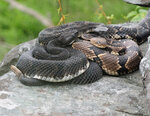We have been getting some mild and even warm days this spring, and we are seeing more animals and more green leaves on the ground and the trees. We’ve heard spring peepers earlier in the vernal …
Stay informed about your community and support local independent journalism.
Subscribe to The River Reporter today. click here
This item is available in full to subscribers.
Please log in to continue |

We have been getting some mild and even warm days this spring, and we are seeing more animals and more green leaves on the ground and the trees. We’ve heard spring peepers earlier in the vernal ponds and wetlands, and the cricket-type noise of the American toad has been heard on many lakes.
A lot of us too have seen some snakes, especially the more common species such as garter snakes, northern water snakes and ring neck snakes.
Timber rattlesnakes, one of only two venomous snakes found in the region, are usually the last ones to be seen during the spring. Unlike the other snake species in the region, timber rattlesnakes are particularly sensitive to the cold. They cannot tolerate temperatures below freezing. Rattlesnakes emerge around now from their dens and are usually out by mid-to-late May locally.
In one den study in which a trail camera was set, the first timber rattlesnake was seen emerging from the den on April 16, and the last one was seen on May 26. After accounting for multiple sightings of particular animals, the count was 38 timber rattlesnakes; this includes a few young-of-year snakes.
Though the timber rattlesnake is native to the region, many people have not seen one, or even know they are in the region. This species prefers undisturbed areas for hibernacula (dens) and summer basking sites; it is usually a challenge to find a timber rattlesnake unless you know where to look.
On occasion, you may run across a solitary male that is miles from any known den. They wander over the course of the summer, looking for food and potential mates.
If you encounter a rattlesnake or hear a rattle on the trail or elsewhere, just stop and stay a few feet away. They are not aggressive, and will only strike as a last resort. They will retreat if given the chance. You can circle around it if you need to get through, or just watch; it will probably be retreating to a crevice or nearby brush off the trail. Take pictures, but keep your distance (200mm or better zoom lenses work well). Do not try to handle the snake; they are protected throughout our region.
Rattlesnakes and other species of snakes are beneficial, in their own way, to the environment. Rattlesnakes are mammal eaters, and help keep the rodent population controlled naturally.
If you see one on your next outing, give it some distance, observe and enjoy.
Comments
No comments on this item Please log in to comment by clicking here